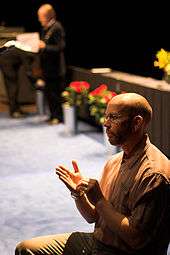Movement (sign language)
In sign languages, movement, or sig, refers to the distinctive hand actions that form words. In William Stokoe's terminology, it is the SIG, an abbreviation of signation. Movement is one of five components of a sign—with handshape (DEZ), orientation (ORI), location (TAB), and facial-body expression. Different sign languages use different types of movement. Some treatments distinguish movement and hold—signs, or parts of signs, that involve motion vs. those that hold the hands still.
Movements in American Sign Language

A sign language interpreter at a presentation. The active, tapered hand has just touched the passive, flat hand.
American Sign Language uses about twenty movements. These include lateral motion in the various directions, twisting the wrist (supinating or pronating the hand), flexing the wrist, opening or closing the hand from or into various handshapes, circling, wriggling the fingers, approaching a location, touching, crossing, or stroking it, and linking, separating, or interchanging the hands. These may be repeated and made large or small and with varying degrees of speed, abruptness, and intensity.[1]
References
- ↑ Stokoe, Casterline, & Croneberg, 1965. A Dictionary of American Sign Language on Linguistic Principles, Gallaudet
|
|---|
|
|
|
| By region[a] | | Sign languages by region |
|---|
| Oceania | |
|---|
| Asia |
- Bengali
- Chinese
- Philippine
- Indonesia: Indonesian, Kata Kolok (Benkala, Balinese)
- India: Alipur, Bengali Indo-Pakistani, Naga
- Israel: Al-Sayyid Bedouin, Ghardaia, Israeli, Kafr Qasem, Yiddish
- Japan: Amami Oshima, Japanese
- Korean
- Malaysia: Malaysian, Penang, Selangor
- Mongolian
- Nepal: Ghandruk, Jhankot, Jumla, Nepalese
- Persian
- Saudi Arabia: Saudi
- Singapore
- Sri Lankan
- Taiwanese
- Thailand: Ban Khor, Thai
- Vietnamese
|
|---|
| Africa | |
|---|
| Europe | |
|---|
| North America |
- Plains Sign Talk
- Canada: American, Blackfoot, Cree, Ojibwa, Maritime, Quebec, Inuit, Plateau
- Mexico: Chatino, Mayan, Mexican
- United States: American (Black American), Blackfeet, Cree, Cheyenne, Ojibwa, Keresan, Martha's Vineyard, Navajo, Navajo Family, Plateau, Sandy River Valley, Henniker
|
|---|
| South America | |
|---|
| International | |
|---|
|
|---|
|
Language
families[a] | | Sign languages by family |
|---|
| | |
|---|
| |
|
|---|
| | |
|---|
| |
|
|---|
| Chinese Sign |
|
|---|
| | | | |
|
|---|
| Austro-
Hungarian |
|
|---|
| Old Belgian | |
|---|
| | |
|---|
| Dutch | |
|---|
| Italian | |
|---|
| Mexican | |
|---|
|
|---|
| | |
|---|
| | |
|---|
| |
- Bangalore-Madras Sign Language
- Beluchistan Sign Language
- Bombay Sign Language
- Calcutta Sign Language
- Delhi Sign Language
- Nepali
- North West Frontier Province Sign Language
- Punjab-Sindh Sign Language
|
|---|
| | |
|---|
| | |
|---|
| | |
|---|
| | |
|---|
| | |
|---|
| |
- Haiphong
- Hanoi
- Ho Chi Minh City
|
|---|
| | |
|---|
| | |
|---|
| Kentish |
|
|---|
| Other |
|
|---|
| Isolates | |
|---|
|
|---|
|
| ASL | |
|---|
|
Extinct
languages | |
|---|
|
| Linguistics | |
|---|
|
| Fingerspelling | |
|---|
|
| Writing | |
|---|
|
Language
contact |
|
|---|
|
| Media |
- Films (list)
- Television programmes (list)
|
|---|
|
| Persons | |
|---|
|
| Organisations | |
|---|
|
| Miscellaneous | |
|---|
|
^a Sign-language names reflect the region of origin. Natural sign languages are not related to the spoken language used in the same region. For example, French Sign Language originated in France, but is not related to French.
^b Denotes the number (if known) of languages within the family. No further information is given on these languages. |
